Todwick Environment: Wild Birds
SK58 Birders – December 2015
by Brian Chambers
The next club meeting will be on Wednesday, 27 January 2016, this will also be the Annual General Meeting. Following official business there will be an illustrated talk from Malcolm Walpole, his subject is entitled “Botswana 2”, having already given a previous presentation on the country this is the next instalment. If your New Year resolution is to support more local events or develop a new interest, then you will be most welcome to give SK58 Birders a try.
Christmas over-eating also means more left-overs for the birds. The Finches still need seeds so perhaps make up a sort of cake mixture to tempt them. Finches form a sort of staple species in the garden so a review of which ones to expect.
House Sparrow is usually the first to think of but their numbers have declined a lot in the last few decades. There are fewer nesting sites now in modern houses and less hedgerows so that must be a factor, this is true of Todwick. However, there are a number of small flocks in the gardens around the village. Males unmistakeable with a rather scruffy brown plumage, black bib and slate grey crown. Females I think always look a bit smarter, light brown birds with a dirty cream eye-stripe.
Tree Sparrow is a smaller bird, less frequent but there is still a small flock in the hedges west of Todwick House Gardens. They have white cheeks and a brown crown. Smart birds.
Chaffinch are the most common, generally preferring to feed on the ground but will use bird tables or feeders. A well-known, colourful species the males sporting a bluish/grey crown, pink chest and prominent white wing-bars. Females again are more subdued.
Greenfinch is another regular visitor, they prefer seed feeders in our garden but will also readily forage on the ground. Males are light green with a yellow wing-bar, females again duller, much less green in the plumage.
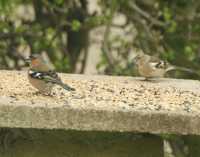
(April 2008)
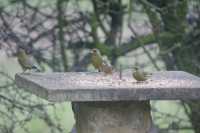
(March 2011)
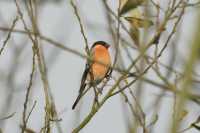
(November 2008)
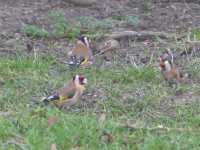
(December 2014)
Click the images to see larger versions
Bullfinch. You need to be lucky to attract this species to the garden, they are quite common along the Chesterfield Canal, preferring natural habitat to village life. Unmistakeable stocky birds, males with a salmon pink chest, black cap and a white rump seen in flight. The birds usually gather in small flocks so a paler female should also be nearby.
Goldfinch are now a common garden bird, loving to visit seed feeders. The bright yellow wing bars easily seen as is the male’s red face.
Best wishes for a happy, peaceful Christmas, please keep feeding the birds in 2016.
SK58 Birders – November 2015
by Brian Chambers
The monthly meeting of the group will be in the upstairs room of the Loyal Trooper, South Anston, on Wednesday, 25 November 2015. Alan Parker, Todwick Birder and Photographer, will give a presentation entitled “Shetland Revisited”. Everybody is most welcome to attend. There will be no December meeting; the next meeting will be on Wednesday, 27 January 2016.
The weather this year has been generally mild, the leaves appear to be shedding later and if our garden is typical of Todwick the birds are not very numerous. I think there must be plenty of food to find in the countryside so they have deserted the garden for the local hedgerows, woods and fields. Good really as an abundance of natural food is surely a good indicator of a healthy environment. However please keep putting out the bird food regularly, birds get to know which gardens to visit, when the weather turns I am sure the birds will be back.
Unusual bird species keep turning up locally. A very rare visitor was a Crag Martin to Chesterfield. This species is one of rock faces of Southern Europe but one has been circling the crooked spire for about a fortnight. It is a brown bird similar in size to our House Martin but without the white rump. Insects must still be in the air for its feed, our own Swallows and House Martins have long since left for South Africa!
There was also a rare visitor seen flying over the Axle Lane fields on the 16 November 2015 – a Great White Egret, similar in size to our familiar Grey Heron but white and with a long neck. Another bird more at home in Southern Europe but a few stray into the UK at this time of year. I think it is the first time one has been recorded in the SK58 area.
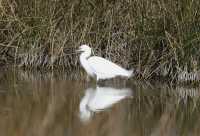
(February 2011)
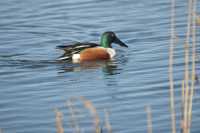
(January 2009)
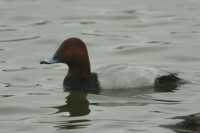
(January 2010)
Click the images to see larger versions
A bit further afield at Langold Lake the usual wildfowl species were joined by three male Shovelers, colourful ducks with large bills – hence the name, they are quite common at Clumber Park. Also present here were a few Pochard ducks, the males with distinctive chestnut-brown heads, a fairly rare duck for SK58 but common at Rother Valley.
This past month has seen a few skeins of Geese flying over our area. These are Pink-footed Geese, they are usually quite high in the sky but their calls can be heard. The skeins, often 100 – 200 birds, are in a basic V formation. The main feeding grounds for these Geese are on the Solway Firth and Norfolk, the ones seen over Todwick will be commuting between these sites, having come from Greenland, Iceland or Arctic Europe.
SK58 Birders – October 2015
by Brian Chambers
The next meeting of SK58 Birders will be held in the upstairs room of The Loyal Trooper, South Anston, on Wednesday, 28 October 2015 with a 19.30 start time. This is a return to our traditional meeting place, decided after the extensive refurbishment and improvement of the pub’s facilities. The talk this month is by Ben Keywood entitled “Wildlife of Vietnam”. 25 November 2015 meeting will feature a talk by Todwick birder and photographer Allan Parker, his subject is “Shetland Revisited”.
Large Gulls flocks have been feeding on the fields towards South Anston. Lesser Black-backed Gulls have been the most numerous. These Gulls do breed in UK coastal regions but numbers are enhanced in the Autumn by birds leaving the cold regions of Scandinavia, Northern Europe and Iceland. 3-400 birds have been counted, as the name suggests they have black or dark grey backs, Great Black-backed Gulls are larger and have definite black plumage on their backs.
The other Gulls feeding with the above are the smaller red-legged Black-headed Gulls. A somewhat confusing name as their heads are a chocolate brown colour and in the Autumn / Winter they lose this hood altogether just having a black spot behind the ear.
Amongst these Gulls a Yellow-legged Gull was recorded during September. These are like the familiar Herring Gull of the sea side but have bright yellow legs instead of ones of a pinkish colour. They are somewhat unusual birds for our region being commoner in the Southern UK and around the Mediterranean.
On the same Axle Lane fields there have been large flocks of Skylark. This species is declining quite disastrously in some areas but not in Todwick. During the summer probably about 20/30 pairs will nest then post breeding flocks of about 400 birds have been counted feeding on the stubble fields.
Linnet flocks of about 300 birds are not uncommon and there have often been good passage numbers of Meadow Pipit, these are streaky little birds which do nest on the local reclaimed pit sites at Dinnington and Kiveton.
The Winter Thrushes are just arriving from the North, leaving the cold of Northern Europe and Scandinavia when their local berry supply runs out to feed on our Hawthorn, Elder and other fruit. Redwing are usually the first here, sporting red side feathers and a prominent cream coloured eye stripe. Fieldfare are often about a fortnight behind, large thrushes with grey heads and orange streaked breasts, very handsome birds. If you have berries in your garden, cotoneaster, pyracantha etc. or fruit such as crabs then you should attract some of these birds. Otherwise they should be present along the Chesterfield Canal, at Kiveton Woodlands and on any Hawthorn tree or hedge or just feeding on the local fields.
Look out for the flocks of Golden Plover if you walk the footpaths to South Anston, they often take to flight then settle on the fields after a while. About 150 birds have been present so far this year, a big reduction from a few years ago when flocks of 2-3000 were the norm.
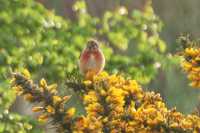
(April 2010)
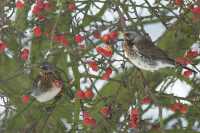
(February 2012)
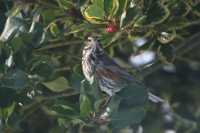
(January 2015)
Click the images to see larger versions
SK58 Birders – June 2015
by Brian Chambers
The May 2015 meeting at Anston Parish Hall was the last meeting before the summer break. The next will be on the last Wednesday of September 2015.
Locally there have been a few interesting bird sightings.
Common Terns have been seen over Langold Lake, in previous years they were quite regular visitors to the Axle Lane fishing ponds, but not anymore. They can travel long distances in search of a good food source, possibly with our local birds coming from the Idle Valley region, 10-15 miles away! Common Tern frequent inland waterways but are more numerous on the coast, very similar to the more northerly based Arctic Tern. They are great to watch as they patrol the lakes and rivers hovering then diving into the water to catch their fish.
The Old Mineral Line footpath in Dinnington is a great linear nature reserve. It starts opposite Thornbury Animal Sanctuary, on the road to Dinnington, and goes as far as Thurcroft. A Quail has been heard calling from the corn fields adjacent to the footpath. This is a small gamebird, smaller than a Blackbird, which is very rarely seen – just heard. It is really a European species but some birds always overshoot on migration and finish up in the UK, for some reason generally preferring barley fields.
Another recent visitor to this spot is a Garden Warbler, despite its name very rarely seen in gardens and not very common elsewhere. It is a plain brown warbler similar in size and song to the more familiar Blackcap.
A Spotted Flycatcher has returned to a familiar site in Lindrick Dale, again not a common bird in our area. 3-4 pairs used to occupy Anston Stones Wood but alas all have disappeared. Their behaviour is very characteristic, perched on a branch they flit out to catch passing insects then return to the same perch. Last year a pair was present near Langold Lake and another in the Roche Abbey / Stone region.
Personally, we have had some great visitors to our own garden. This week a great Spotted Woodpecker has discovered our plentiful supply of peanuts and fat balls, gathering a mouthful and then feeding her young offspring which waits either on the grass or perched on a nearby branch. Also feeding has been a pair of Pheasant, a pair of Red-legged Partridge, a Jay and a Squirrel collecting and burying nuts. Then there has been a young Mistle Thrush, many Chaffinch, Greenfinch, Yellowhammer, Blackbird and Robins and Wrens. The past week has been as good as I can remember, hopefully your gardens are also full of birds.
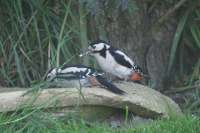
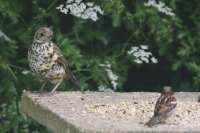
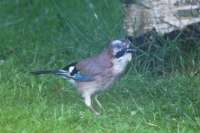
Click the images to see larger versions
SK58 Birders – April 2015
by Brian Chambers
This month’s meeting of the SK58 Birders will be held, as usual, at Anston Parish Hall, a 7.30 pm start. Carl Dixon will give a presentation entitled “Peru”.
If you fancy an early start to the day our bird recorder, Andy Hirst, will be at the Hide on Dinnington Community Woodland from 5.30 am to listen to the DAWN CHORUS. It’s a good chance to appreciate the morning bird song and perhaps learn a few of our common birds’ songs.
Migration is well under way now. The fields either side of Axle Lane, the track to South Anston, are a good site. Wheatear have been seen quite often, the male a stunning bird with an orangey breast, grey back, black eye mask and in flight a very obvious white rump, the female a duller version. They often favour perching on the old stone wall, dropping down to find some insect food. Sometimes there are a few birds and they tend to stick together so if you see one a search may reveal others.
Yellow Wagtails are also just returning, they favour the rape seed crops and are unmistakeable with their yellow plumage and long tail, another colourful, attractive bird. Also in the rape crop there are a number of Reed Bunting, again easy to recognize with their black heads. (There is a photo of a Reed Bunting below.)
Overhead, especially on a warm sunny day are singing Skylark. These fields are still a strong hold for this species, I would think at least 20 pairs nest here, still able to find food despite all the crop spraying that occurs.
Also, often perched in the trees by the wall, about 200 yards from the Todwick end, is a Little Owl. The bird was seen last year and probably raised a brood, it’s good to see it back in the same spot. Little Owls are often seen perched during daytime.
Locally along the Chesterfield Canal and at Kiveton Community Woodland the Warblers are in good song. Willow Warbler and Chiffchaff the most common, both little brown birds but with very different songs. Also warbling away are Blackcaps, the male has a black cap, the female a brown cap, often skulking in the hedges but whilst the leaves are not quite out a good time to get a view.
Great Crested Grebe can be seen displaying at Langold Lake, elaborate head shaking dances as they form pair bonds.
Local rarities include a few sightings of Red Kite over the South Anston area and a Ring Ouzel on the old pit site at Thurcroft.
SK58 Birders – February 2015
by Brian Chambers
This month’s meeting date is 25 February 2015, 7.30 pm at Anston Parish, the talk and slide show by Brian Chambers is entitled “India”. 25 March 2015 will be the meeting date when Mike Richardson will give a presentation entitled “Norway & Israel in Winter” As ever anybody is welcome to attend, there is a £2 fee for non-members which goes towards the cost of hiring the hall.
Our members have not reported many bird sightings this month, either because they have been housebound by the cold, breezy, sometimes snowy weather or because there has not been much of interest around on which to comment. The plus about poor weather is that birds will come into the gardens in greater numbers than is usual, that is if you place plenty of food. My own garden has had 30+ yellowhammer, they prefer to feed on the ground whereas Greenfinch favour the seed feeders – 30+ of them too. Good numbers of other species to feed are Chaffinch, Blackbird, Blue Tit and a count of 5 Reed Bunting.
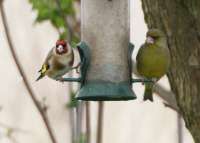
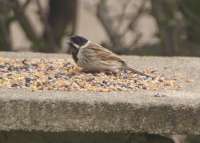
Click the images to see larger versions
Locally this month two Peregrine Falcon were seen hunting over the Axle Lane fields, their usual prey of Golden Plover are rather scarce this year but there are plenty of Woodpigeon to go after.
A Red Kite has been recorded over the Sandbeck Estate and Firbeck this month. These birds have been re-introduced in a number of areas in the country, nearby on the Harewood Estate. This programme has been a huge success so birds are spreading into adjacent habitat, there is no reason why our area should not support them, there is plenty of road kill food for them to scavenge.
A Merlin was spotted over the Hodsock area, not far from the Priory. The fields here support good Wintering flocks of Linnet, Skylark, Meadow Pipit and Wagtail – all good target species for this little Raptor, it leaves its moorland habitat during the Winter months.
So, that is 3 Raptors to see if you are in the right place at the right time. More common Raptors are the Buzzard, often over the Todwick area, Kestrel the hovering bird of prey and Sparrowhawk. The presence of Sparrowhawk increases the more we attract birds onto our feeding stations, an unfortunate sequence of events but all species have to live and fight for survival.
SK58 Birders – January 2015
by Brian Chambers
SK58 Birder’s New Year programme starts with our AGM and monthly meeting at 7.30 pm, Wednesday, 28 January 2015, as usual at Anston Parish Hall. The Speaker is our own Bird Recorder, Andy Hirst, his talk is entitled “Jizz and all that Jazz”. As ever, everyone is welcome to attend. The following month I will give a talk and slideshow based on a trip to Northern India, this is on 25 February 2015.
This time of year is excellent for seeing woodland birds generally hidden by foliage. The birds often form winter foraging flocks, the greater numbers help in locating a good food source, also there is some safety in numbers from Sparrowhawk and other raptors.
The Tit family are a good example. There are the Blue and Great Tit familiar from garden bird feeders. These search the tree branches for small insects, spiders, grubs, etc. flitting about in groups.
Then there are the less familiar Long-tailed Tits, unmistakeable with their long tails and rounded head shape. They also maintain constant contact calls. Often quite large flocks of 20+ birds form, if watched along the Chesterfield Canal they can often be seen steaming across the water one after the other, making counting easy.
Coal Tit is always a good find, the black head and bib combining with a white patch on the nape help identification, the flanks often show a slight pinkish hue. These will visit your garden nut feeders in winter; usually they nip onto the feeder then are away in a second, this sort of behaviour alerts you to the possibility of the bird being a Coal Tit.
Two similar species are Marsh and Willow Tit, both have black heads and bibs. Unfortunately, both are suffering a decline nationally but the Marsh Tit is doing OK in our area. They are best separated by call, the Willow a nasal drawl, the Marsh an explosive pi-choo sort of call. Both species are present along the Chesterfield Canal.
One bird often mixing in the Tit flocks is the Goldcrest, our smallest bird. Usually very mobile but if you spot a rounded blob of a bird with a golden crest and a prominent eye then that’s it.
Walks along the Chesterfield Canal, through Anston Stones Wood or around Kiveton Woodlands are all good local sites for these species.
One other visible species is the Great Spotted Woodpecker. Often clinging in upright pose to branches at the top of the trees. A sharp “kick” call alerts you to its presence, also at this time of year they are starting to “drum”. This is a sound made by the bill striking the wood, preferably dead wood, in rapid succession for about a second. As with most bird sounds this is either a mating or warning call.
Yes, Winter walks through the woodland can reveal some good bird sightings.
Continue to 2014 reports.
